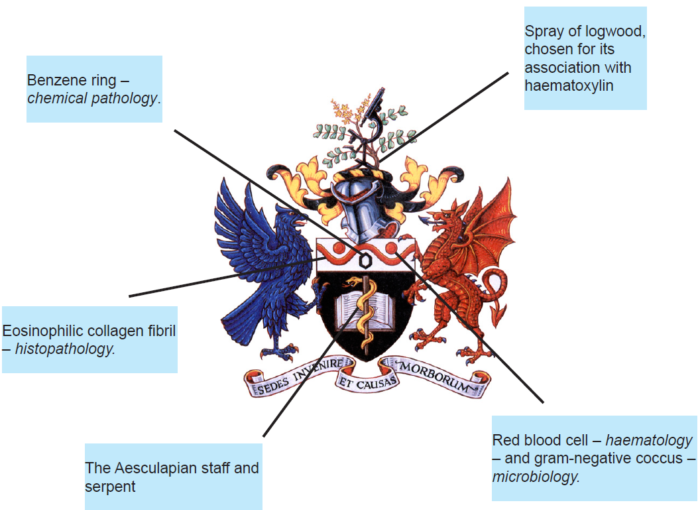The right to bear heraldic coat of arms is an honour bestowed by the reigning monarch on individuals or institutions. The College was granted this distinction in December 1963, before receiving its ‘Royal’ accolade from the Her Majesty The Queen by charter in 1970.

The shield
The shield bears reference to the medical and educative roles of the College. In the centre there is an open book, the Aesculapian staff and serpent. The upper part, or ‘Chief’, depicts the (then) four main pathology disciplines using heraldic symbols: the red wavy line represents an eosinophilic collagen fibril – histopathology; the red circles above the wavy line represent a red blood cell – haematology – and gram-negative coccus – microbiology, while the shape beneath the wavy line represents a benzene ring – chemical pathology.
Rod of Asclepius
In Greek mythology the Rod of Asclepius is a serpent-entwined rod wielded by the Greek god Asclepius, a deity associated with healing and medicine. The symbol has continued to be used in modern times, where it is associated with medicine and healthcare,
The helmet
The helmet is a type that would have been worn by an esquire or gentleman because the visor is closed. This reflects the status of pathologists as members of the medical profession. A spray of logwood, chosen for its association with haematoxylin, sits behind a silhouette of a microscope designed for Joseph Lister.
Haematoxylin, is a compound extracted from the heartwood of the logwood tree. Haematoxylin and eosin together make up haematoxylin and eosin stain, one of the most commonly used stains in histology.
Supporters
In 1970 the College was granted its Royal Charter and the coat of arms had to be altered to incorporate ‘supporters’. The left-hand supporter is a blue eagle with its wings expanded, representing enlightenment and learning. The right-hand supporter is a red dragon with its wings expanded, representing evil, disease and death. The pair represents the fight between knowledge and the prevalence of disease.
The motto
The College’s Latin motto is Sedes invenire et causas morborum – ‘to seek the sites and causes of disease’. This resonates in our 21st century logo through the strapline, Pathology: the science behind the cure.

